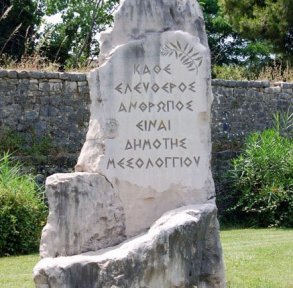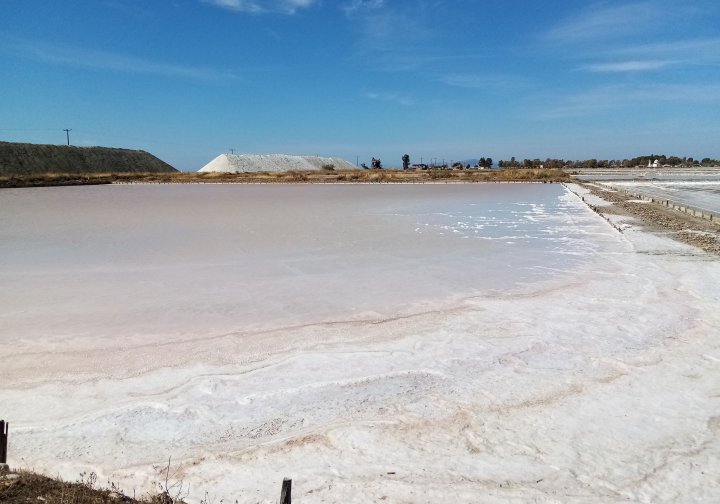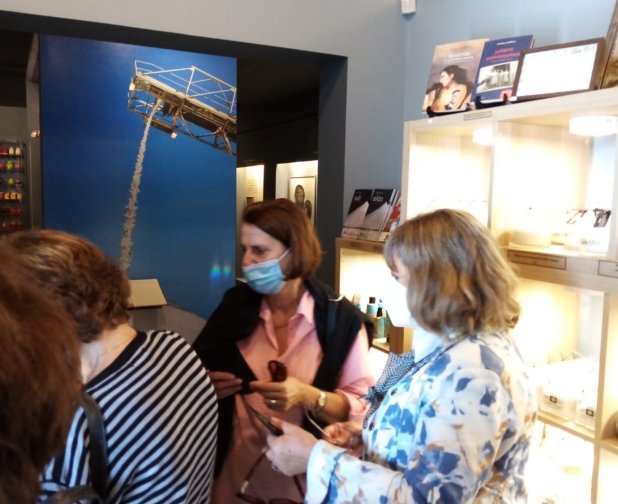MESSOLONGHI and NAFPAKTOS

The CULTURAL SOCIETY LONGOS "LORD BYRON" organized in cooperation with MATTHEOS-TOURS - Aigio a one-day excursion toMESSOLONGHI and NAFPAKTOS
|

|
|
Service charge: 14,00 € per person.
All measures against the pandemic were complied with.
(Evidence of vaccination or recovery or rapid test required)
PROGRAMDeparture at 8:00 am from Longos (well on Efkalipton Street) to Rio. There ferry to Antirio. Continue to Messolonghi. We will enjoy our morning coffee outside of Messolonghi and then visit Tourlida which was an island in the Kleisova lagoon until 1885.There we will admire the pelades (stilt houses). At 11 a.m., a guided tour of the Messolonghi Salt Museum awaits us. (Entry ticket 1.50 euros per person.)
Morning coffee at Messolonghi:
Then we will drive to the city center of "Iera Poli" Messolonghi. Optional visit to the house of Charilaos Trikoupis and the History Museum of Messolonghi, housed in the old town hall. Lunch in the beautiful taverns of the city. In the early afternoon we meet to visit the Heroes Park in the northern part of Messolonghi. There are the bones of Markos Botsaris as well as many other heroes of the Greek revolution. The park's 69 monuments are historical works of art. Our excursion continues with afternoon coffee in Nafpaktos. We can stroll on the city's beautiful coastal road, admire the castle and the Venetian harbor with the stone lighthouse, and relax in one of the countless cafes. In the early evening our bus takes us over the Rio-Antirio bridge back to Longos.
|

| 
| 
|
MESSOLONGHI
|
Messolonghi is a municipality of 34,416 people (according to the 2011 census) in western Greece. The town is the capital of Aetolia-Acarnania regional unit, and the seat of the municipality of Iera Polis Messolongiou. Messolonghi is known as the site of a dramatic siege during the Greek War of Independence, and of the death of poet Lord Byron.
When the Greek War of Independence broke out in spring 1821, Missolonghi was the first place in western Greece to join the uprising, on 20 May 1821, under the leadership of the town notables, chiefly Athanasios Razikotsikas, Panos Papaloukas, and A. Kapsalis. With rumours of Greek successes in the Morea and eastern Greece spreading throughout April, most of the Turkish families of the town had already evacuated to nearby Vrachori, where there was a strong Ottoman military presence. Missolonghi was soon reinforced by the klepht chieftain Dimitrios Makris, who immediately occupied the nearby island of Anatoliko; there too, the few Turks abandoned the town without resistance and made for Vrachori. Its location made it a vital bastion to the Greeks in the War of Independence: protected by a chain of small islands and its lagoon from the sea, and by a wall and the marshy terrain from the landward side, it was strategically located near the Peloponnese and the Ionian Islands. Coming from Marseilles, Alexandros Mavrokordatos landed in the town in July, and made it the base of his attempts to form his own power-base in western Greece, independent of the authority of Dimitrios Ypsilantis in the Morea. On 4 November, Mavrokordatos and his political allies convened an assembly of regional representatives in the town, which established a separate governing body, the "Senate of Western Continental Greece". The town's fortifications were initially limited to a ditch 2 metres (6.6 ft) wide and 1.2 metres (3.9 ft) deep, in many places filled up with rubbish, as well as by a small wall, not higher than 1 metre (3.3 ft) and in need of repair, with fourteen guns.[6][9] Nevertheless, the city held out against the first Ottoman attempt to capture it in 1822. A 7,000-8,000 strong Ottoman army under Omer Vryonis and Mehmed Reshid Pasha laid siege to the city on 25 October 1822. The small Greek garrison of 500 men, under Mavrokordatos, managed to delay the Ottomans by pretending to negotiate a surrender until the Greek fleet landed reinforcements on 8 November. The subsequent Ottoman attacks were beaten off, and the onset of winter, disease, and the attacks of other Greek forces from the rear under Georgios Karaiskakis forced the Ottoman commanders to lift the siege on 31 December 1822. A second Ottoman attack, led by Vryonis and Mustafa Pasha of Scutari, was launched on 20 September 1823, and focused mostly on Anatoliko. Facing the onset of winter, disease, the failure of the simultaneous Ottoman operations in eastern Greece, and Greek attacks on their foraging parties, the Ottoman commanders abandoned the siege on 17 November. Another siege started on 15 April 1825 by Reşid Mehmed Pasha whose army numbered 30,000 men and was later reinforced by another 10,000 men led by Ibrahim Pasha, son of Muhammad Ali Pasha of Egypt. After a year of relentless enemy attacks and facing starvation, the people of Missolonghi decided to leave the beleaguered city in the "Exodus of its Guards" (The Sortie) on the night of 10 April 1826. At the time, there were 10,500 people in Missolonghi, 3,500 of whom were armed. Very few people survived the Ottoman pincer movement after the betrayal of their plan. Due to the heroic stance of the population and the subsequent massacre of its inhabitants by the Turkish-Egyptian forces, the town of Missolonghi received the honorary title of Hiera Polis (the Sacred City), unique among other Greek cities. The famous British poet and philhellene Lord Byron, who supported the Greek struggle for independence, died in Missolonghi in 1824. He is commemorated by a cenotaph, containing his heart, and a statue located in the town.
Landmarks:
Messolonghi Salt Museum Learn more ... |
 |
 |
 |
 |
 |
 |
 |
 |
 |
 |
 |
 |
 |
 |
 |
 |
 |

|
NAFPAKTOS
|
Nafpaktos is a town and a former municipality in Aetolia-Acarnania, West Greece, situated on a bay on the north coast of the Gulf of Corinth, 3 km (2 mi) west of the mouth of the river Mornos.
It is named for Naupaktos, an important Athenian naval station in the Peloponnesian war. As a strategically crucial possession controlling access to the Gulf of Corinth, Naupaktos changed hands many times during the Crusades and the Ottoman–Venetian Wars. It was under Venetian control in the 15th century, and came to be known by the Venetian form of its name, Lepanto. It fell to the Ottoman Empire in 1499 and was used as naval station by the Ottoman Navy in the 16th century, being the site of the decisive victory by the Holy League in the Battle of Lepanto in 1571. Except a brief period of Venetian control in 1687–1699, Lepanto remained under Ottoman control until Greek independence in 1829. The modern municipality was incorporated in 1946, but merged into the larger Nafpaktia municipality in the 2010 reform. Nafpaktos is now both the name of a municipal unit within Nafpaktia and of the town proper within the Nafpaktos unit. The municipal district has an area of 159,947 square kilometres (61,756 square miles), with a population close to 20,000 as of 2011. The town is 9 km (6 mi) northeast of Antirrio, 18 km (11 mi) northeast of Patras, 35 km (22 mi) east of Missolonghi and 45 km (28 mi) southeast of Agrinio. The Greek National Road 48/E65 (Antirrio – Nafpaktos – Delphi – Livadeia) passes north of the town. It is the second largest town of Aetolia-Acarnania, after Agrinio.
Landmarks:
|